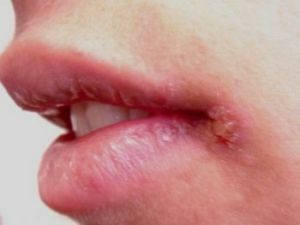 Among the many diseases affecting the area of the lips, cheilitis is not in last place. It can occur both in young people and in older people.
Among the many diseases affecting the area of the lips, cheilitis is not in last place. It can occur both in young people and in older people.
There are quite a few of its varieties, among which there is a special emphasis on grandular cheilitis, which is a pathology that results in damage to the lips due to impaired salivary glands.
In most cases, the lower suffers. The development of the disease is promoted by hyperfunction of the congenital or acquired species, heterotopia or hyperplasia of the glands responsible for salivation. More often the disease occurs in men in adulthood.
Contents
- Primary and secondary forms
- Provoking factors
- Symptoms of simple and purulent form of the disease
- Diagnosis and treatment
- Preventative measures
Primary and secondary forms
Two types of grandiose cheilitis are distinguished in medical practice:
- Primary arises as an independent disease and is not associated withwith other pathologies of the lips. On their surface, red dots with enlarged openings of small glands form, over which droplets of saliva accumulate. With a long course of the disease, precancerous lesions are possible.
- Secondary form is a consequence of any disease in persons without congenital anomalies. The openings of the ducts increase even more, the lips drastically swell, and when touched they feel painful. Purulent drops appear on the mucous membrane. The mouth is constantly in the open position.
Aggravating factors
Among the main factors provoking cheilitis of the primary form, allocate:
- hereditary predisposition;
- deviations at the genetic level.
When parents have an increased level of glandular secretion, the risk increases that a child at birth will already have the same problems. 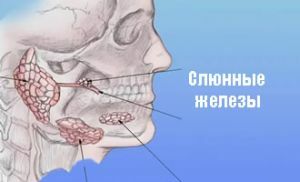
The reasons for the secondary type of illness include:
- periodontitis;
- parodontosis;
- the presence of tartar;
- sick teeth with sharpened edges;
- inflammation of the epidermis of the lips.
A timely treatment can prevent the possibility of deep lesions of the glands.
Symptomatics of simple and purulent form of the disease
Glandular cheilitis is accompanied by characteristic clinical symptoms and external signs( see photo below).At the initial stage of development on the lips red small points are formed. As a result of abundant salivation, the lips are all the time moistened, but when the liquid evaporates, the skin is peeling, which leads to small cracks. The lower lip is affected more often than the upper lip.
A brighter picture is observed with purulent cheilitis. Patients complain of swollen lips and pain in this area. As a result of the examination, puffiness and hyperemia are detected. The surface of the lips is covered with abscesses. As a result of the palpation, seals are revealed, which is accompanied by pain. When you click on the affected area, saliva with purulent impurities is released.
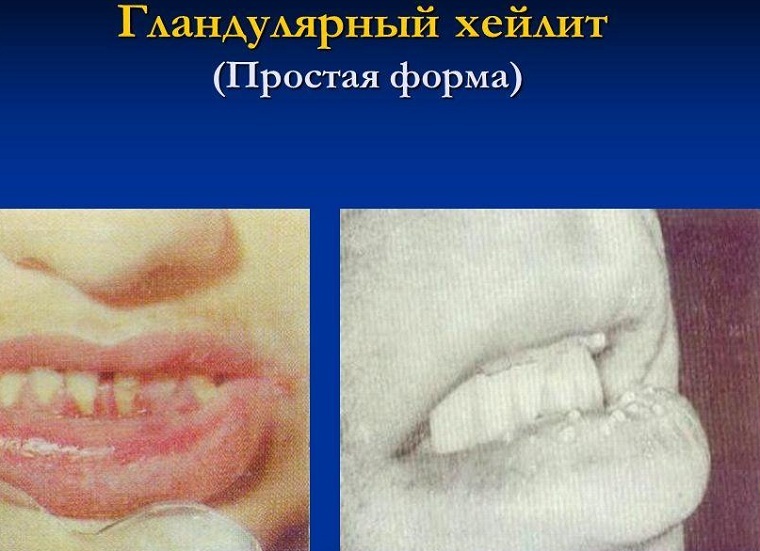
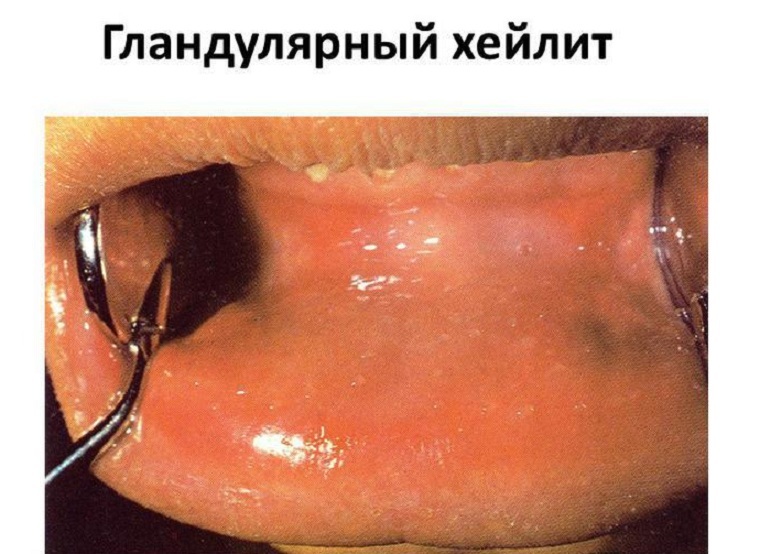
Diagnosis and treatment
To confirm the diagnosis, a biopsy is performed, as well as histological examination of the salivary glands. These methods allow to reveal hypertrophy and weak inflammatory infiltration near the excretory ducts. In some cases parakeratosis and acanthosis can be detected.
The most reliable method of treatment is electrocoagulation. The basis of this operation is the use of a waxy electrode, which is injected directly into the body of the salivary gland. When applying surface coagulation, a retention cyst may develop.
If a patient has a sufficiently large number of pathological changes in the glands during the diagnosis, then they are excised. 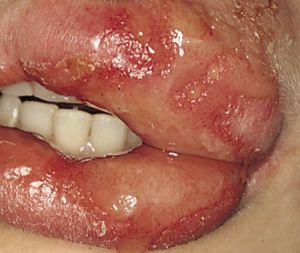
The essence of the operation is that through the oval incision, which is done along the Klein line, the hypertrophied tissues are harvested and the catgut sutures are applied. Before the surgical intervention, anesthesia with a 2% solution of Trimekaine or Novocain is mandatory, which allows painless removal of the pathological gland.
Conservative treatment of glandular cheilitis is carried out in two stages. The basis of the first includes:
- use of anti-inflammatory drugs - applications using sintomitsinovoy emulsion and ointments, for example, Lokakorten or Sinalar;
- hygiene and sanitation of the oral cavity;
- rejection of bad habits;
- rational prosthetics;
- measures aimed at treating the underlying disease and suppressing the causes that provoked the development of cheilitis;
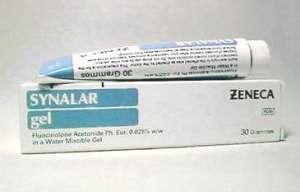
- applications with the help of enzymes - it can be Himopsin, Lysozyme, Deoxyribonuclease, Trypsin, - this compress is done for 15 minutes once a day;
- aerosols for lip irrigation - among the most effective isolate Olazole, Livian, Propasol, Panthenol, Levovinizol. It is necessary to conduct the procedure up to four times a day, the duration of each is not less than 25 minutes.
In the second stage, when grandular cheilitis acquires a purulent form, electrocoagulation, surgical excision or Bucca borderline rays are used.
In any form of the disease, the following groups of drugs are prescribed:
- tranquilizers and sedatives;
- vitamin B5 and A;
- multivitamins containing trace elements;
- are vascular.
With timely diagnosis and properly prescribed treatment, the disease can be eliminated.
In the case of an advanced stage of pathology and in the absence of necessary therapy, the risk of developing a squamous cell tumor of the lip increases.
Preventive measures
As a rule, the development of primary cheilitis is not possible to prevent, since at birth, the child already has an anomaly in the salivary glands.
Prophylactic measures can be applied only to the secondary form of pathology. It is necessary to constantly maintain the oral cavity in a normal healthy state, perform daily hygienic procedures, treat dental and gum diseases in time, as well as other diseases of the oral mucosa.
